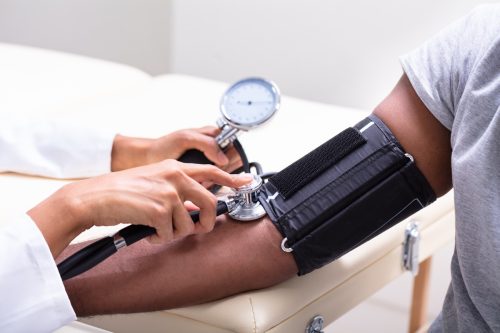I Walked 10,000 Steps for 30 Days and This Is What Happened

Looking to transform your health? You may be able to do so in a few simple steps, researchers say. A recent study published in the European Journal of Preventive Cardiology made waves in the wellness world when it announced that taking just under 4,000 steps per day can significantly improve heart health and reduce your risk of dying from any cause. However, the positive health effects only increase with each additional 1,000 steps you take beyond that number. Benefits purportedly include improved cardiovascular health, better physical endurance, enhanced mood, reduced cancer risk, and more.
To put the theory to the test, Netflix filmmaker and YouTuber Matt D’Avella committed to documenting his own 30-day walking challenge. While taking an aspirational 10,000 steps per day, he weighed himself daily, tracked his blood pressure, collected data on his heart rate, and more—all in an effort to determine how his step count might impact his health.
The experiment marked a major departure from his normal activity levels. D’Avella says that though he regularly lifts weights and considers himself generally active, he averaged under 4,000 steps per day prior to beginning the experiment, an amount that reflects the average American’s daily step count, according to the Mayo Clinic.
“If there’s one area I definitely ignore, it’s cardio. I rarely hit the treadmill, I don’t run… I want to finally add more movement into my daily routine, and so, I’m going to walk 10,000 steps per day,” he says in the popular YouTube post, which has garnered nearly two million views.
After 30 days, the filmmaker says he was surprised by the results. Read on to find out how walking 10,000 steps per day made a difference in D’Avella’s life.
RELATED: Why Walking Only 3,867 Steps a Day Is All You Need, Science Says.
At first, he struggled to find the time for it.

D’Avella says that the first thing he noticed about his new walking regimen is how difficult it is to prioritize it in your schedule.
“One thing that was clear as I made my way through the first week is that it’s not always easy to find the time [to walk]. It is surprisingly difficult to get 10,000 steps into the day. I keep finding myself checking my tracker at 8pm at night and realizing that I’m 2,000 or 3,000 steps short. And so, what I’ve had to do is go out after dark and walk around my neighborhood, which is not creepy at all,” he says sarcastically.
He began focusing on incidental exercise.

In an effort to create a sustainable schedule that he could carry on after his 30 days were up, D’Avella says he began to focus on getting his steps in earlier in the day. He also committed to increasing his incidental exercise.
“Incidental exercise is any movement done in small amounts that adds up over the course of the day,” he explains. “We all have choices that we make each day that impact the amount of movement that we get, like taking the stairs instead of the elevator, walking the long way to the gym, or using a smaller cup of water so you have to refill it more often. This type of exercise requires less effort than carving out a dedicated hour to go to the gym and can be built off everyday activities and routines.”
Soon after implementing this new strategy, D’Avella says he started to notice a difference in his step count: “A few hundred steps here, a couple thousand steps there.” By simply doing more chores around the house, walking instead of driving to meet friends for dinner, or taking his work calls on the go, he found it much easier to meet his step goals.
RELATED: Walking Pads Are the Latest Wellness Trend Everyone’s Talking About.
Eventually, D’Avella started to enjoy his walks.

What at first felt like a chore eventually became something D’Avella looked forward to, he says in the video.
“I started casually listening to history podcasts, I listened to walking meditations, I walked silently around my neighborhood, and I explored new hiking trails around Sydney, and this has honestly become my favorite thing about this city. There are dozens of beautiful hikes, from the bush to the beaches. There are stunning views and moments of complete immersion in nature.”
He also began burning more calories.

Just as he started to find the joy in walking, D’Avella says he also started to notice some tangible results on his fitness tracker.
“I’ve exercised more, climbed more flights, done more steps, and had more running and walking distance,” the YouTuber explains.
D’Avella notes that he also started burning more calories as a result of his increased activity. Before, he burned an average of 470 calories per day, but walking raised this number to over 650 per day.
However, D’Avella says that he began and ended the month at the same weight: 160 pounds.
“If all things had remained equal, you would have expected my weight to go down with the additional calories burned, but my sister was visiting for three weeks during this experiment. I know it’s a terrible excuse, but I ate out and drank a lot more than I typically would have.”
RELATED: 26 Amazing Health Benefits of Walking.
His energy levels improved.

D’Avella says that by the end of the month, he noticed a difference in his energy levels.
“I feel a lot better, I do,” he reports on day 30 of the experiment. “I feel a lot better now that I have gotten this extra cardio in, even if that cardio was as simple as walking more.”
In fact, D’Avella often found himself surpassing his 10,000-step goal toward the end of the month, averaging over 12,000 steps per day. In total, the filmmaker says he took roughly 364,000 steps throughout his month-long experiment.
His other health data points remained unchanged—for now.

D’Avella says that his blood pressure and resting heart rate were at healthy levels to begin with, and they stayed roughly the same from the beginning to the end of the experiment. However, he says he plans to maintain his higher levels of physical activity now that the experiment is over, aiming for at least 7,500 steps per day to reap the health benefits.
Doctors agree that increasing your step count by any amount can be beneficial to your health—and that every little bit of movement is worth the effort.